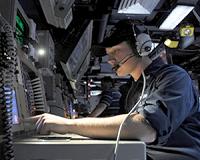 |
Brussels, Belgium (RIA Novosti) Sep 20, 2010 Russia believes that Moscow and NATO should properly assess missile risks before starting on a missile defense plan for Europe, Russia's envoy to the military alliance said on Friday. "We continue to insist that, before discussing what may be meaningful in the framework of the possible European missile shield project and other serious projects, we need to carry out a serious analysis of missile threats," Dmitry Rogozin told RIA Novosti. "To settle on guilty parties in this issue means to dodge a discussion of more serious issues," Rogozin said. "It is not only Iran that possesses missiles in Europe's southern 'underbelly,' but other countries as well, so if we are to start this analysis, we should analyze all those who possess this kind of technology." Iran still poses a threat to Russia and NATO, the alliance's Secretary General Anders Fogh Rasmussen said earlier on Friday. He reiterated calls for the creation of missile defenses in Europe, saying they would bring NATO and Russia closer.
Source: RIA Novosti
earlier related report "Goal, goal, goal!" fans in the stadium are absolutely ecstatic, the uproar is enormous. So it's hardly surprising that the security personnel fail to spot a brawl going on between a few spectators. Separating jubilant fans from scuffling hooligans is virtually impossible in such a situation. Special surveillance cameras that immediately spot anything untoward and identify anything out of the ordinary could provide a solution. Researchers from the Fraunhofer Institute for Applied Information Technology FIT in Sankt Augustin have now developed such a device as part of the EU project "SEARISE - Smart Eyes: Attending and Recognizing Instances of Salient Events". The automatic camera system is designed to replicate human-like capabilities in identifying and processing moving images. Like the human eye, it can, for instance, distinguish objects when observing a scene, even if the objects are moving in front of a very turbulent background. The Smart Eyes system analyzes the video data in real time and immediately points out salient features. "That is invaluable for video surveillance of public buildings or places", says Dr. Martina Kolesnik, research scientist at the FIT. "In certain circumstances the capabilities of a human observer are limited. Ask someone to keep an eye on a certain stand in a football stadium and they are bound to miss many details. That same person can only carefully monitor certain sections of the whole area and will quickly get tired. That's where Smart Eyes clearly comes into its own." The system hardware consists of a fixed surveillance camera which covers a certain area, and two ultra-active stereo cameras. Like human eyes, these can fix on and follow various points very quickly in succession - but also zoom in on details. At the heart of Smart Eyes is innovative software that automatically analyzes the image sequences. It replicates key strategies of the human eye and brain. Taking its lead from the flow of visual images in the brain, the software has a hierarchical, modular structure. It initially ascertains the degree of movement for each pixel, thus identifying the particular active areas in the scene. From this it learns motion patterns and stores them as typical models. On the basis of these models the system then identifies events and classifies them: for instance the software can distinguish between passive spectators and fans jumping up and down. Image patterns such as empty seats or steps are also identified. The application picks out salient events and focuses on these using the active stereo cameras. Depending on the priorities set by the security experts, various events are designated as salient. The program can, where necessary, filter out objects such as flags being waved to focus specifically on other salient events, for instance a person on the edge of the pitch. "Our image analysis software is compatible with camera systems produced by all vendors. It can be installed easily. The user doesn't have to make any adjustments", says the researcher.
Share This Article With Planet Earth
Related Links - Learn about missile defense at SpaceWar.com Learn about nuclear weapons doctrine and defense at SpaceWar.com All about missiles at SpaceWar.com Learn about the Superpowers of the 21st Century at SpaceWar.com
 Second Generation Aegis BMD Capability Completes Formal Testing
Second Generation Aegis BMD Capability Completes Formal TestingMoorestown NJ (SPX) Sep 21, 2010 Lockheed Martin recently demonstrated the second generation of its Aegis Ballistic Missile Defense (BMD) capability in a formal U.S. Navy test event. This configuration, known as Aegis BMD 4.0.1, enables the U.S. Missile Defense Agency (MDA) and the Navy to defeat more complex ballistic missile threats and also introduces the BMD signal processor, which improves target identification. ... read more |
|
| The content herein, unless otherwise known to be public domain, are Copyright 1995-2010 - SpaceDaily. AFP and UPI Wire Stories are copyright Agence France-Presse and United Press International. ESA Portal Reports are copyright European Space Agency. All NASA sourced material is public domain. Additional copyrights may apply in whole or part to other bona fide parties. Advertising does not imply endorsement,agreement or approval of any opinions, statements or information provided by SpaceDaily on any Web page published or hosted by SpaceDaily. Privacy Statement |